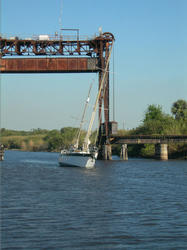|

Success, I'm through with no damage and inches to spare. The low water level made the normal 49 be 51.87 clearance, my mast light is 54.3, add 17 degrees of heeling with 4000 pounds of water on the side deck and I fit. I can't believe, I (an engineer?) didn't have a calculator, slide rule or math book and had to do the trig and math by hand using the small angle trig aproximation, pythagorean theorem and long hand square roots. Can you do that off the top of your head? Maybe I am still an engineer, maybe even old school type. I just re did the math with a calculator and I must have had 17.5 degrees since I fit, 17 wouldn't do it, glad I filled up those three five gallon pails, big wash basin and the plastic shipping box. I still had another 55 gallon colapsable drum and a 20 gal plastic tank I didn't fill. The drum is for drinking water, I didn't want to contaminate with river water if I didn't have too and the tank, I couldn't find a good place for, so I figured I'd see if I had enough with what I had. If not I still could have moved hundreds of pounds of interior contents and hang the filled drum from the swung out boom. I knew if I spent the time and went through everything I had I would find a calculator or math tables, turns out windows has a scientific one if you know how to bring it up, now I know. I would do this with basic in the old days, you wouldn't have to enter the numbers over and over when doing a trial and error solution. I sure miss not having basic language on my pc. Ah the good old days when I thought nobody would ever write a program that would take more than 1k of memory.
I set up the 45 degree mirror at the top of the mast, my brothers idea, but with the excitment of the moment didn't try to use it, I was fighting a 15-20 knot head wind at the time and keeping the boat online was more important. My trial fit was much faster than I would have liked. I probably was going 1/2 knot, (with fingers crossed real hard) I had to have some way on to keep control in the wind. You say that's not very fast, 46,000 pounds moving at a 1/2 knot can do a lot of damage to mast top fittings at any speed. I would have rather been going about .001 knots. The mast top light support tube has been drilled to hopefully allow an inexpensive failure for such an event, but the wind indicators and sensors would suffer greatly. A spring wire with flourecent ball a foot in front of the mast would be a good idea. I also think I'll make a little crows nest at the mast top to have secure footing when working up there. Electronic remote steering is also on my wish list, often steering from the front deck (at night, in front of all your lights, or close quarters obstacle avoidance) would be helpful. When I work on the auto pilot I'll think about adding this feature. I'll try to have it steer to compass, steer to wind, or remote.
|
|
|
Happy, I'm finally on the last leg to LaBelle. The tanks are empty and I'm back on the level, hoping I don't have to refill them to heal over again and reduce my keel depth. My draft is 6 foot but I'm travelling through a reported 5.5 channel, my fingers are crossed hopefully I don't find the high spots. Another series of challenges met and conquered. Even if it's a rainy day, the sun is shining inside.
In the beginning of this last leg from lake Okeechobee to Moore Haven Lock, I often "Cleaned the Barnacles off" only once found a rock. Most of the time it was a slightly perceptable deceleration, the rock was definite hit, bounce, bounce, bounce. That's one of the reasons I wanted a steel hull. I probably did more damage to the rock then my hull. Travelling late at night one or more of the navigation beacons was out and at mignight I over ran a channel 90 degree turn by about a mile, I was looking for a place to anchor out away from the channel, I found it, LOL. I still have never hooked up the depth meter. I suspected I was out of the channel when I started that continous percetable deceleration, a quick 180 and I retraced my path as best as possible until I was in deep water, I had 6 inches under my keel. I anchorred out for the night, fired up the GPS and computer and found out where I was. The next morning I had more than the peceptable deceleration turning the corner just outside and 100 feet from the Clewiston lock. I spent about 5 minutes mostly using reverse prop wash to dig me out. I was able to spin the boat around backtrack a hundred yards and try again, moving over to the other side of the channel. No problems over there. Once in the river it was easy going, but I always wonderred when the next slow down would hit me. |